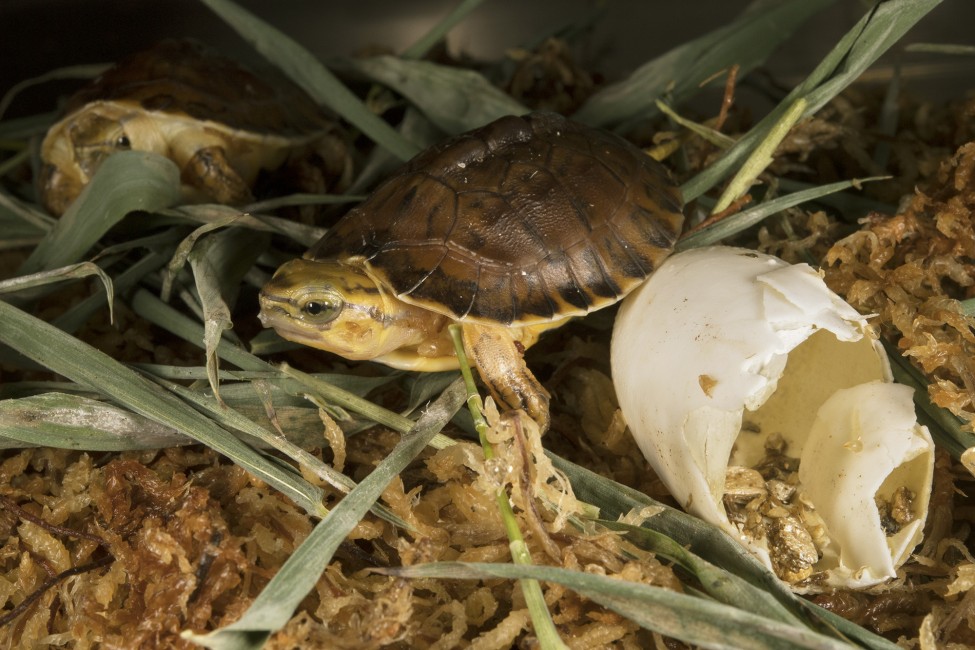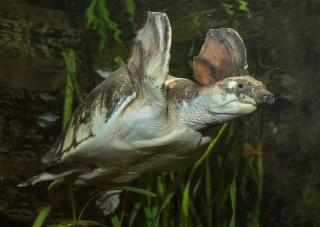
May 28, 2019
A Rare Turtle Hatch
- as seen by -
 Micah Siegel
Micah Siegel
The elusive McCord’s box turtle (Cuora mccordi) is a rare and poorly understood species. This turtle is Critically Endangered on the IUCN Red List of Threatened Species. It was first described in 1988 and not spotted in the wild by herpetologists until nearly two decades later. They are native to a small area of China’s Guangxi province though their true range could be larger. Like other box turtle species, McCord’s box turtles have a flexible shell that they can fully hide in and close when they feel threatened. Though they only grow to about eight inches in length, their rusty brown shells in contrast with their bright yellow heads and limbs make them a visually striking species.
Due to their rarity, there is unfortunately little data about their natural habitat, behavior, or diet. As a result, much of what is known about these turtles comes from observations of captive individuals. They appear to be a primarily nocturnal species, and during the day, they will rest by digging into the soil. Though they will occasionally eat some fruit and vegetation, they prefer a mostly carnivorous diet.
Sadly, this species faces many threats in the wild. Exploitation for food and traditional medicine have contributed to the drastic decline in wild populations. Combined with severe habitat loss, over collection for the pet trade, and heavy pollution, experts speculate that McCord’s box turtle may be near extinction in their native Guangxi. The recent creation of protected areas in the province may be a safeguard against complete disappearance. However, it is currently unknown how many turtles live in those areas, if any do at all.
Fortunately for McCord’s box turtles, they adapt to captivity well and will readily breed when given the proper care. WCS’s Bronx Zoo recently welcomed two McCord’s box turtle hatchlings for the first time in the Herpetology Department’s history. After weeks of monitoring the eggs, checking their daily progress, and counting down to their anticipated hatch date, it was rewarding to witness two healthy turtles take their first steps out of the egg. It’s always exciting when an egg begins to hatch, but given the rarity of this species, being a part of this process was particularly inspiring.
These tiny turtles currently reside in the World of Reptiles nursery at the zoo. Pay a visit and you may catch a glimpse of these secretive hatchlings. Though to date there is no plan to reintroduce captive-born turtles to the wild, the success of the McCord’s box turtle in zoos in the US and overseas provide a glimmer of optimism for the future of this species.
Nikon D5




Leave a Comment
Torsten Blanck - IUCN TFTSG
May 29, 2019 at 3:59 am
Well, a good achievement, congratulations. But let me correct some of the statements that are just not fully correct.
1. The area cannot be much larger, its a remote mountain area surrounded by extensive lowlands that do not offer any habitat. Unfortunately many breed this species now but nobody cares about the last few km² of remaining habitat that is under heavy logging pressure. As such I would recommend (as I already did before) the WCS and all other NGOs that bother about turtles should invest more efforts into this. They do not occur in ANY or near any Reserve. If we loose this last remaining area what is the point to conserve them in captivity?!….
2. it was only consumed by locals which did not seem to harm the population and not affected by the TCM/Food trade in China, its only enemy was the pet trade and to a lesser extend the habitat destruction back before they were extirpated in the wild, but this habitat is being destroyed right now .